Boston Japanned Furniture
THE exoticism of the East has long whetted the imagination of Western man. In our early decorative arts, the colonies felt shimmers of the Orient through ceramics, textiles, furniture, and books. Whether these were actual productions of the East or not made little difference. Precision was not a requisite to the eighteenth-century mind when sublime remoteness could provide delight through flights of fancy.
In furniture, the true Oriental lacquerwork could not be produced in the West, but simplified imitations became popular in Holland and England by the end of the seventeenth century. In the 1700s, Indian work, or japanning as it became better known, spread to the colonies; Boston and New York became the major centers of this work. First prize goes to Boston, with over a dozen japanners working prior to the Revolution and with an array of varied examples of their works still preserved.72
Boston japanners simplified the European process in two ways. The base paints were applied directly over the wood, usually maple in casepieces and pine in clocks, rather than the paint being put over a layer of whiting which was used by the English and New Yorkers to fill in the surfaces of oak or other coarser-grained woods. In English japanning the colors were transparent ones, with seed-lac varnish mixed in with the pigments.73 The Boston japanner used plain oil colors and after raising his figures with whiting, a gesso-like material, gilded them with metallic powders or leaf, painted in details with lampblack, and then varnished the finished product. Interestingly enough, these colonial simplifications were frequently used in English japanned pieces during a later eighteenth-century revival of the art.
The designs themselves were delightful. Chinese buildings, bridges, faceless people, birds, and strange flora of all sorts mingled with griffins, fierce dragons, double-humped camels, unseaworthy boats, plodding wheelbarrows, and pompous horsemen in a scaleless world of make-believe. Many motifs reappear with much variation and little or no duplication on several pieces, but a careful examination of the decorations produces two distinct impressions: that with many qualified japanners working in Boston, it is virtually impossible to separate their work with few exceptions; and that a careful observer will ultimately be struck more by a strabismal myopia than by a pat set of attributions.
At the moment, there are less than half a dozen candidates for known examples by known japanners. The first, and most frustrating, is a tall case clock made by Benjamin Bagnall, formerly in the Philip L. Spalding Collection, bearing the engraved trade card of Thomas Johnston (also spelled Johnson).74 The fact that the case has been refinished to its naked native pine tearfully removes it as the Rosetta Stone for Johnston’s work.
The second example is a William and Mary style high chest of about 1720 at the Adams National Historic Site in Quincy, Massachusetts. The chest is signed by William Randle,75 a Boston japanner, who advertised in The Boston News-Letter of April 25–May 2, 1715: “Looking-Glasses of all sorts, Glass Sconces, Cabbinetts Escrutoires Chests-of-Drawers, Tables, Beaufetts, Writing Desks, Bookcases with Desks, old Glasses new Silvered, and all sorts of Japan-work, Done and Sold by William Randle at the Sign of the Cabbinett, a Looking-Glass Shop in Queen-Street near the Town-House Boston.” The Adams high chest has much of its original raised work on the drawers but contains some nineteenth-century overpainting on the moldings and legs. The large, prominent figures are not unlike those on other William and Mary high chests (fig. 44) or the Queen Anne high chest (fig. 35) signed by Robert Davis, another Boston japanner.
The Davis high chest, the third documented example of Boston japanning, is a flat-topped high chest of about 1735 with cabriole legs and pad feet in the collection of the Baltimore Museum of Art.76 Unfortunately, the ravages of neglect and proximity to a fire have relieved the piece of all of its minor flat decoration, and only parts of its major scenes remain. The three-lobed plants, figures, and animals tie in with the vocabulary of other japanners; their boldness and larger scale are representative of the earlier Boston work before the 1740s. Another high chest that can be linked to Robert Davis, with similar decoration and even cabinetmaking details, was shown in Antiques, lxv (February, 1954), 103, and is now in the collection of the Shelburne Museum.
The other candidates are two tall case clocks by Gawen Brown, the japanning of which can be linked to Thomas Johnston by circumstantial evidence. The first, a magnificent example at Winterthur (fig. 36), is in an early style. Brown came to Boston in 1748, and one of his earliest advertisements in The Boston Evening-Post (January 16, 1749) stated: “That Gawen Brown, Clock and Watch Maker lately from London, keeps his Shop at Mr. Johnson’s, Japanner, in Brattle-Street, Boston, near Mr. Cooper’s Meeting House, where he makes and sells all sorts of plain, repeating and astronomical Clocks, with Cases, plain, black Walnut, Mahogony or Japann’d.”77
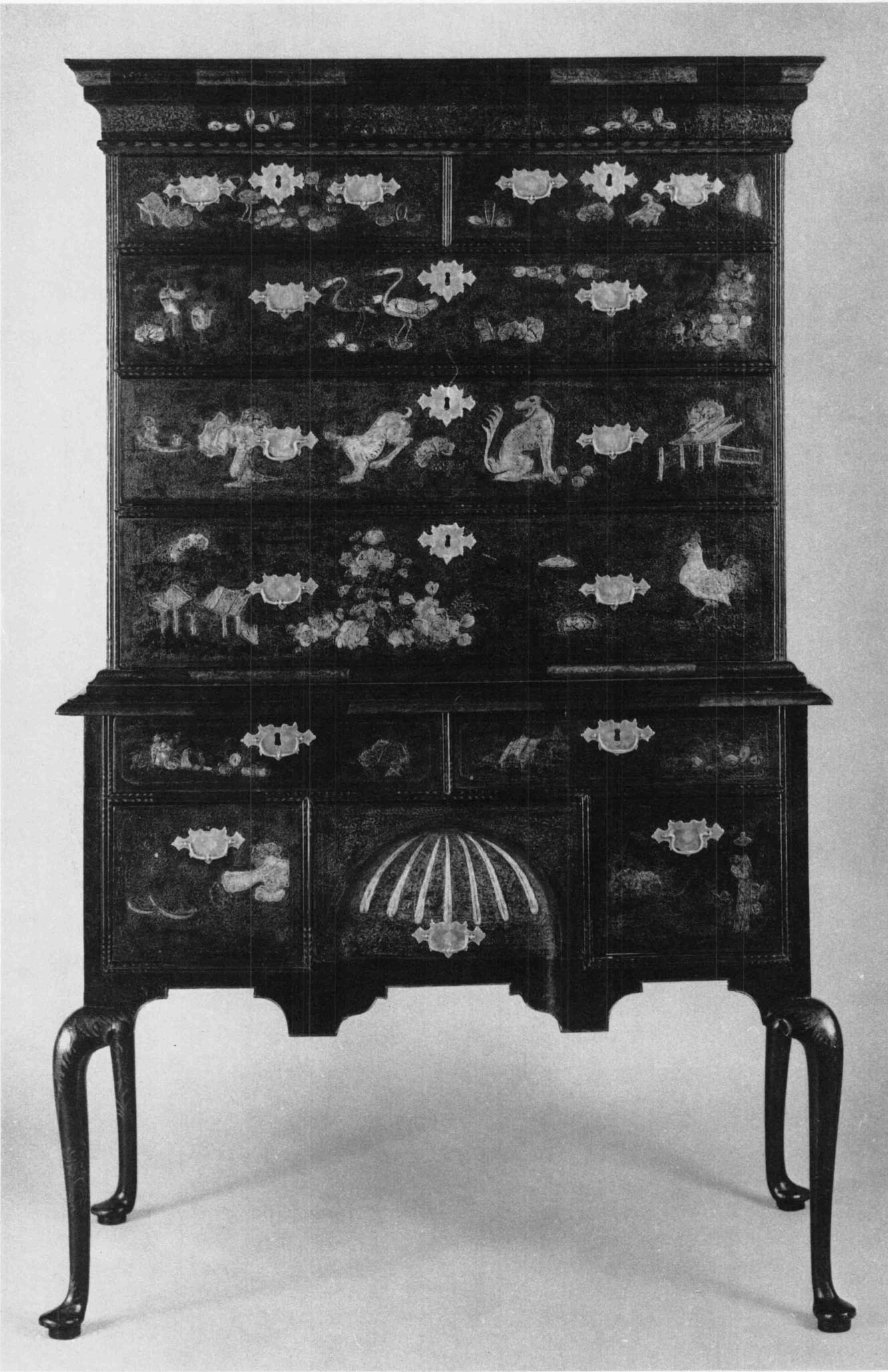
35. High Chest. Japanned by Robert Davis, Boston, c. 1725–1739. Maple and white pine; h. 68⅞ inches, w. 41¾ inches, d. 22⅞ inches. (The Baltimore Museum of Art.)

36. Tall Clock. Works by Gawen Brown, japanning attributed to Thomas Johnston, Boston, c. 1749. White pine; h. 94½ inches, w. 22¼ inches, d. 10¾ inches. (The Henry Francis du Pont Winterthur Museum.)
From this, it would appear that Johnston can be considered the japanner of the clock. The buildings, bridge, sultan, and equestrian figure do not appear with any real similarities on any Boston high chests, which have their own formulas for decoration. However, these clock motifs do appear in identical fashion on a rather disheveled case on another Gawen Brown clock at the Henry Ford Museum.78 These are the only two pieces of Boston japanning I have been able to find with identical decoration throughout. Due to his importance, Johnston has been associated with other japanned pieces. The great high chest at Winterthur (fig. 37) made by the cabinetmaker John Pimm for Commodore Joshua Loring, probably the summit of American japanning, has been linked to Johnston without foundation.79 It was undoubtedly japanned by the same unidentified person as the fine high chest at the Museum of Fine Arts, Boston, notable for the excellent condition of its decoration (fig. 38).
The 1732 Johnston trade card has also provided overoptimistic opportunities for attributions. The dropped finials of a flat-topped high chest at Winterthur (Downs, American Furniture, no. 187) have been likened to those on the trade card. Another group consists of two high chests with broken-arch tops at Bayou Bend (fig. 39) and the Metropolitan Museum of Art (fig. 40), both of which have cherubs in their upper sections. Cherubs also appear on the sign in Johnston’s trade card. Unfortunately cherubic and finialistic hopes do not make firm attributions, and these two high chests, one with a matching dressing table (fig. 41) and all with similar decoration to another matching flat-topped high chest and dressing table (figs. 42 and 43), must remain in the limbo of anonymity until more persuasive testimony is offered.
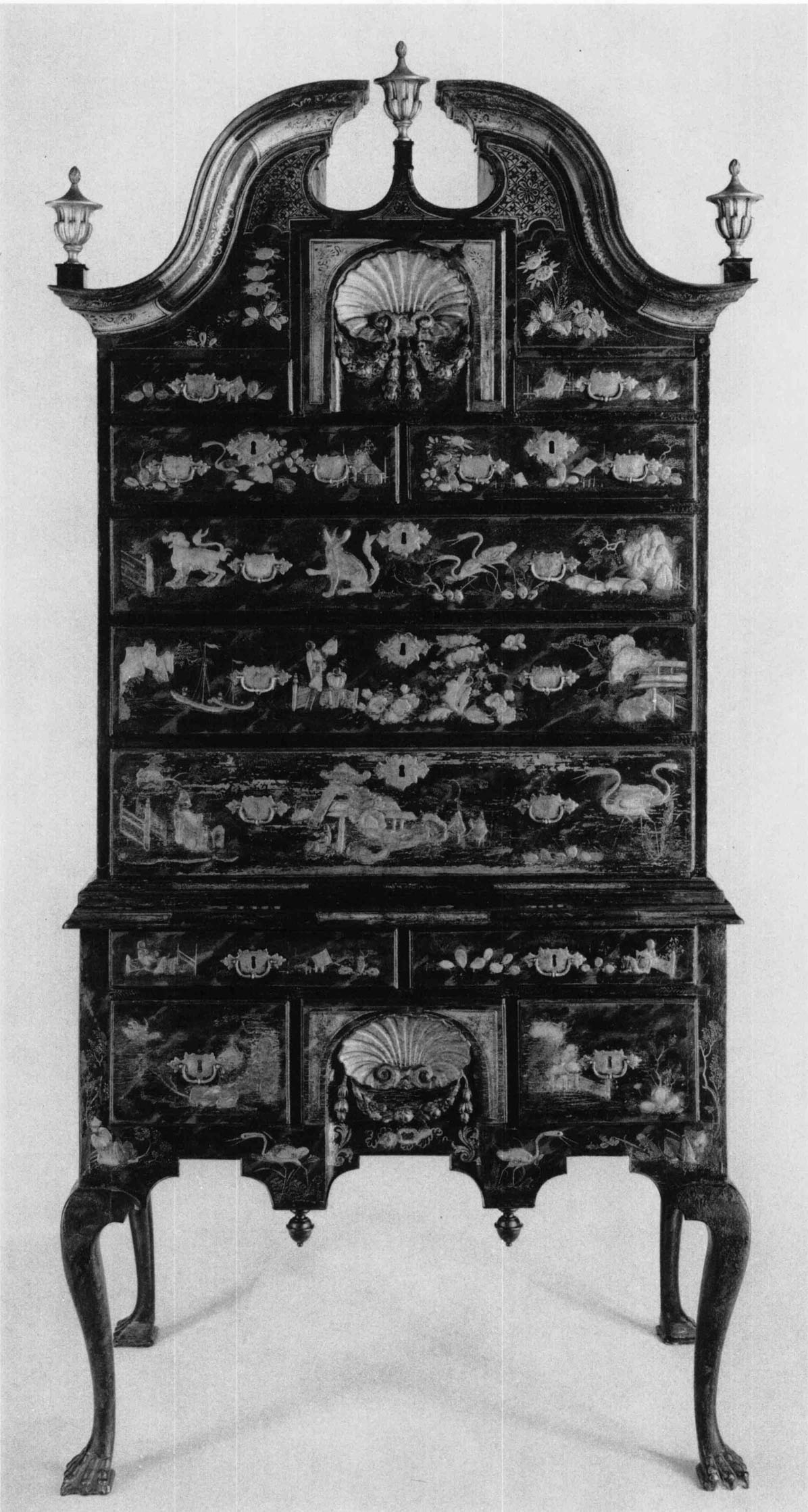
37. High Chest. Made by John Pimm, Boston, c. 1740–1750. Maple and white pine; h. 95¾ inches, w. 42 inches, d. 24½ inches. (The Henry Francis du Pont Winterthur Museum.) According to family tradition, this chest was owned by Joshua Loring (1716–1781) of Jamaica Plain and Boston.
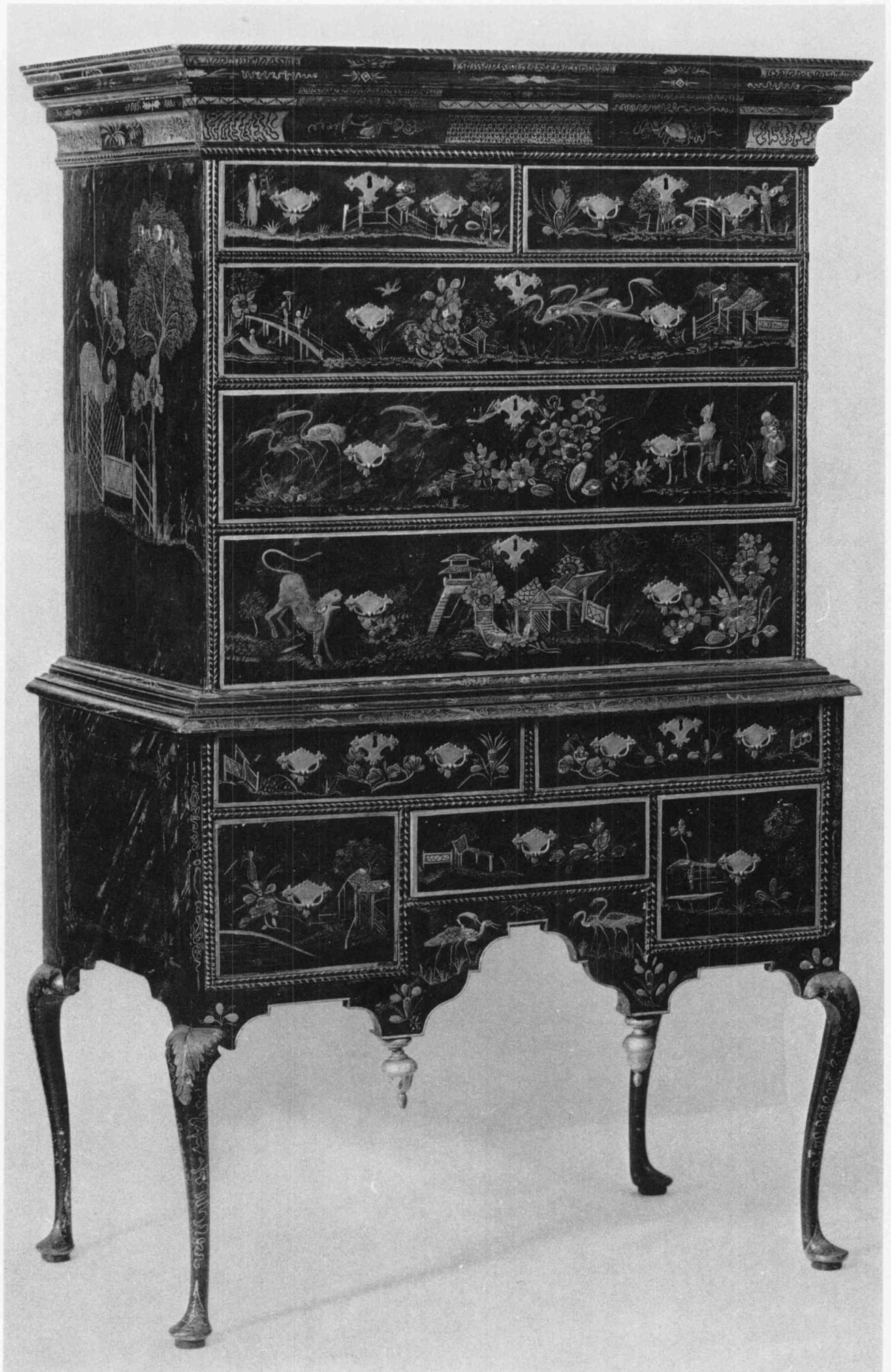
38. High Chest. Boston area, c. 1725–1740. Maple and white pine; h. 71¾ inches, w. 42⅞ inches, d. 24¾ inches. (Museum of Fine Arts, Boston, Bequest of Charles Hitchcock Tyler, 32.227.)
Other examples of Boston japanning include a six-legged William and Mary high chest with bold figures on a black ground at the Metropolitan Museum (fig. 44) and two similar six-leggers with more intricate decoration, one at Winterthur (much of its decoration gone), and one at Historic Deerfield, Inc. (fig. 45). Most of the earlier examples (to the 1730s) have black backgrounds, while the tortoiseshell grounds (black over red) became more popular in the 1740s and later. The motifs in the decoration tended to become smaller and fussier as time went on.
The sources of the designs in Boston japanning were many. Homage is always paid to Stalker and Parker, whose book A Treatise of Japanning and Varnishing, published in Oxford in 1688, was the first work devoted to the subject. Not only were twenty-four plates of chinoiserie motifs included, but the book also served as a basic painter’s guide, its prose style being the most lively ever in the field. While it and several other books in the eighteenth century proclaimed the glories of japanning to Englishmen in Europe and America, it was through a vast number of imported pieces that the designs were spread.80 A handsome japanned English ball-foot desk and bookcase owned by Governor James Bowdoin is at the Detroit Institute of Arts (figs. 46 and 47). English japanned looking glasses have been found locally, and English clocks with japanned cases owned in the Boston area include examples with works by James Atkinson, Edward Faulkner, Richard Motley, and Thomas Wagstaffe.81 Imported japanned examples were advertised from 1716 on with some frequency.
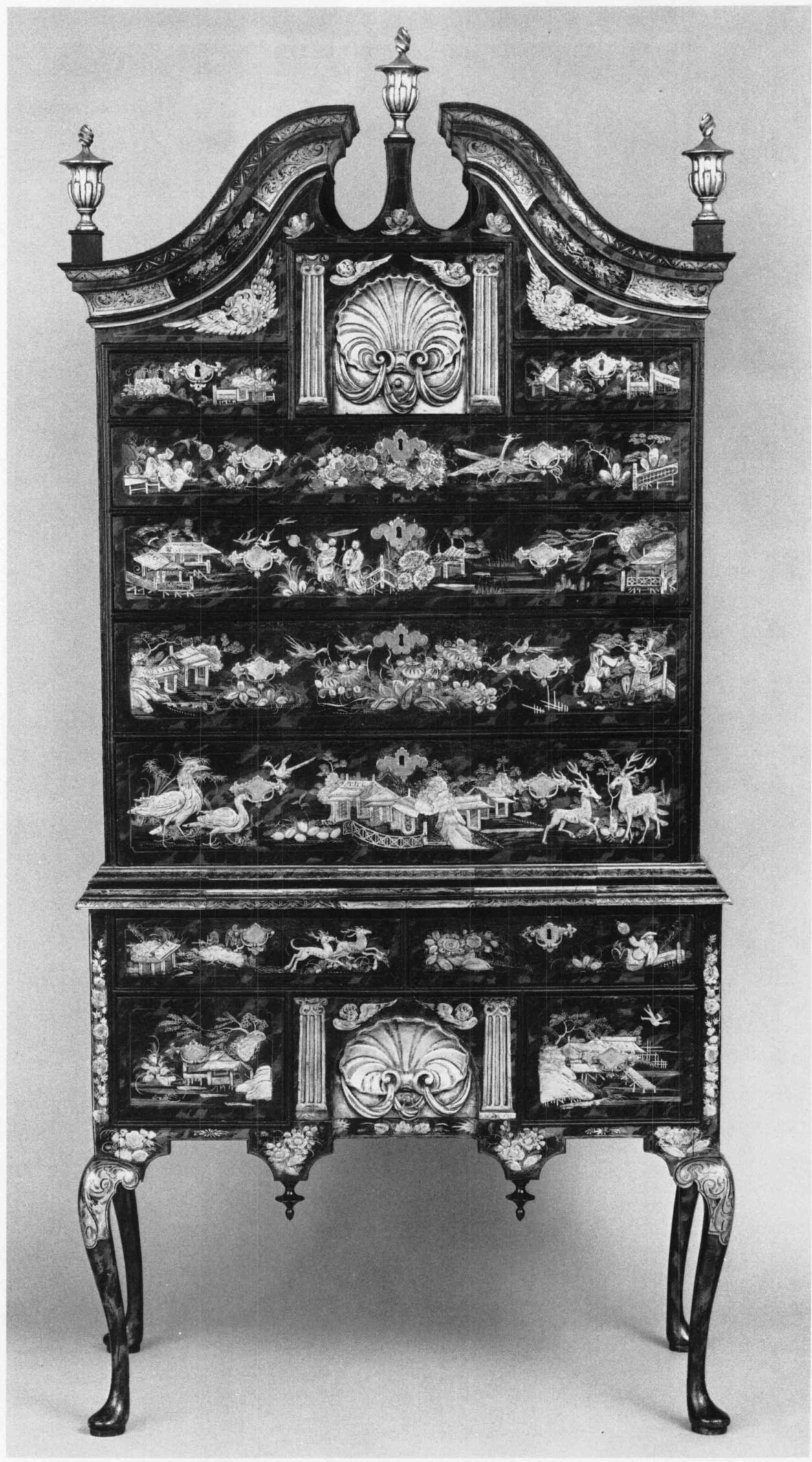
39. High Chest. Boston area, c. 1730–1750. Maple and white pine; h. 92½ inches, w. 41 inches, d. 23 inches. (The Bayou Bend Collection of the Museum of Fine Arts, Houston.)
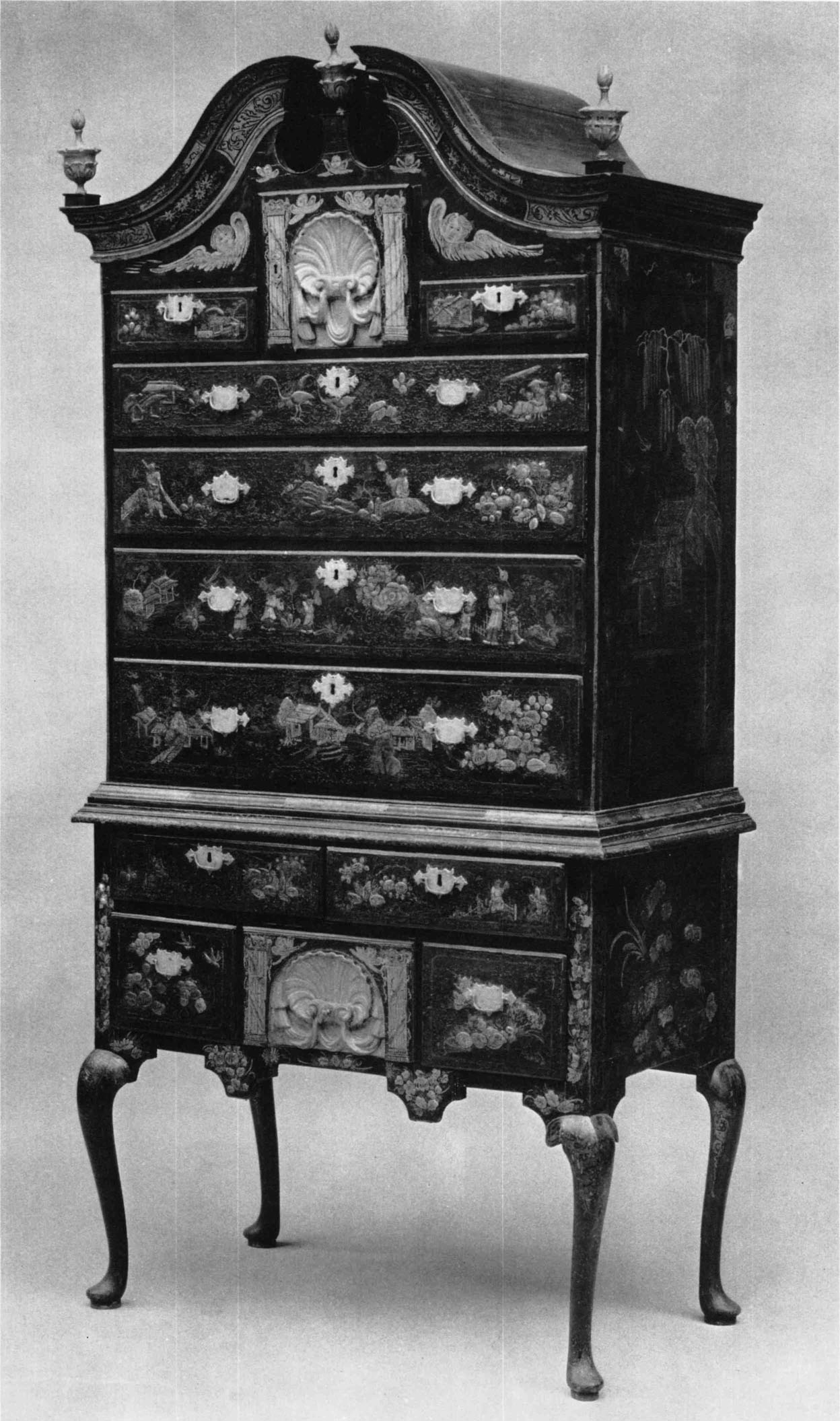
40. High Chest. Boston area, c. 1740–1750. Maple and white pine; h. 86¾ inches, w. 41 inches, d. 22 inches. (The Metropolitan Museum of Art, Pulitzer Fund, 1940.) According to family tradition, this chest and matching dressing table (fig. 41) were owned by Benjamin Pickman (1708–1773) of Salem.
The number of forms bearing japanned decoration and made in Boston exceed those of any other area in America. While only looking glass frames and clock cases are known in New York, Boston examples include these forms plus chests, high chests of drawers, dressing tables, and picture frames. The often cited advertisement of William Price in the April 4–11, 1726, Boston Gazette listed japanned chests of drawers, corner cupboards, large and small tea tables, etc., “done after the best manner by one late from London.” Thomas Johnston’s 1732 trade card also lists japanned chests of drawers, chamber tables, tea tables, writing desks, and bookcases.82 Japanned tea tables are listed in several Boston inventories and other advertisements, and surely a good maple example must yet lurk somewhere with its decoration largely intact.
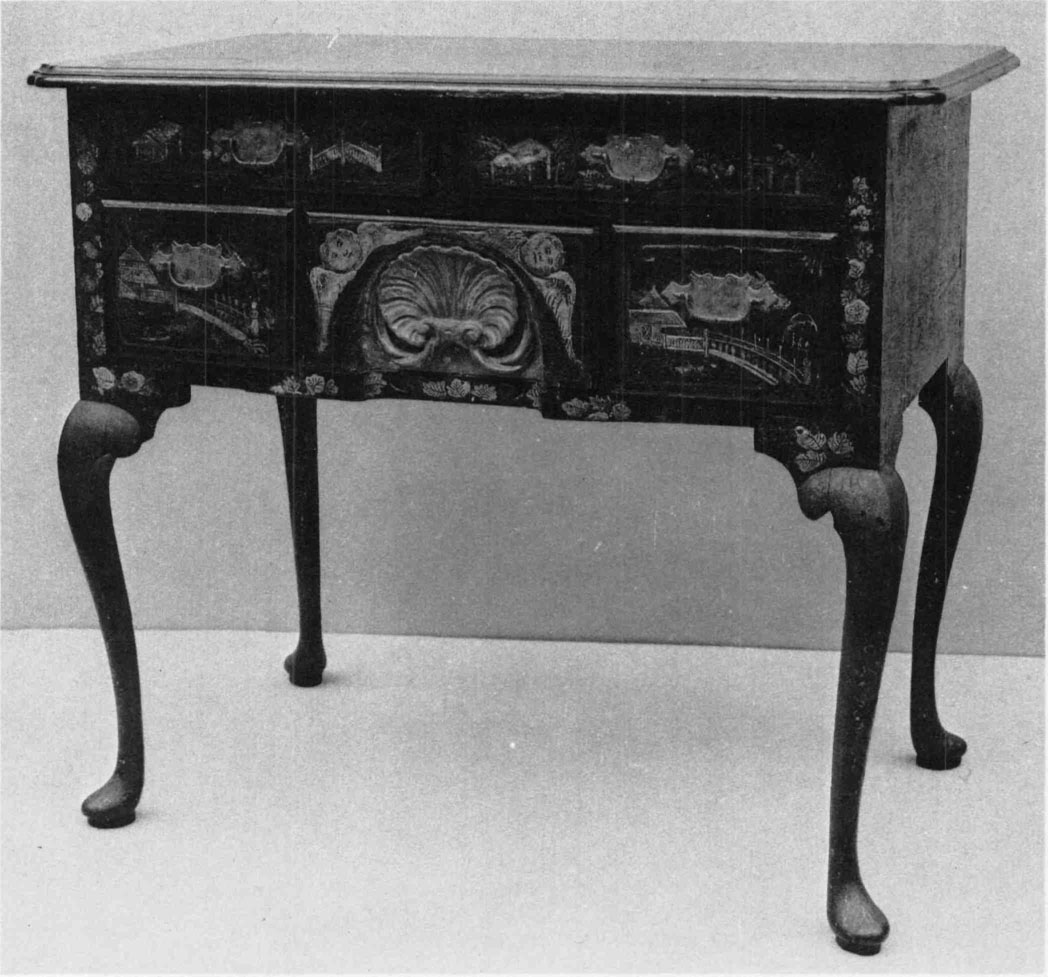
41. Dressing Table. Boston area, c. 1740–1750. Maple and white pine; h. 30 inches, w. 33½ inches, d. 20¾ inches. (The Metropolitan Museum of Art, Pulitzer Fund, 1940.) This table is a mate to the chest illustrated in fig. 40.
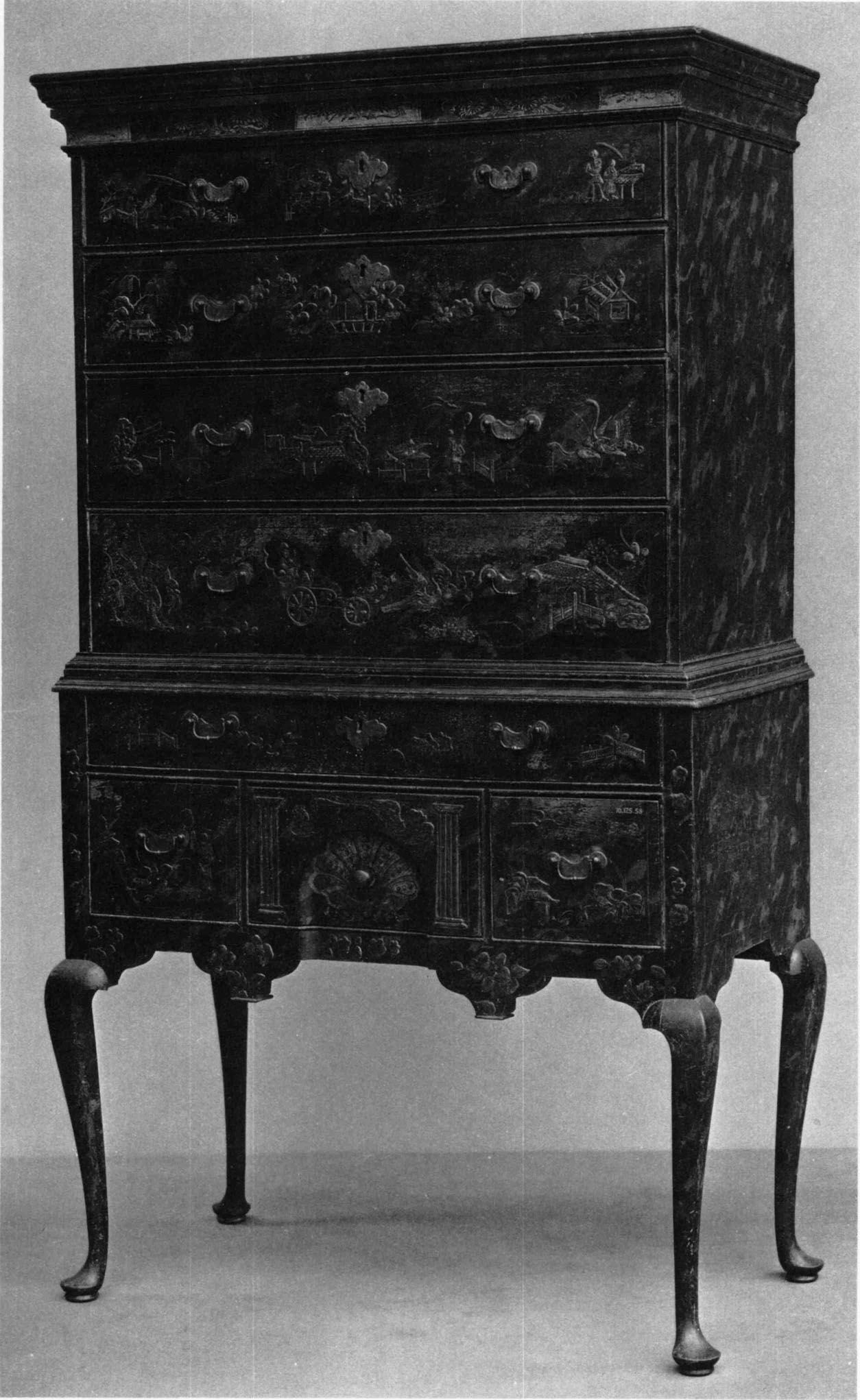
42. High Chest. Boston area, c. 1730–1750. Maple and white pine; h. 70¼ inches, w. 40 inches, d. 21¾ inches. (The Metropolitan Museum of Art, Gift of Mrs. Russell Sage, 1910.)
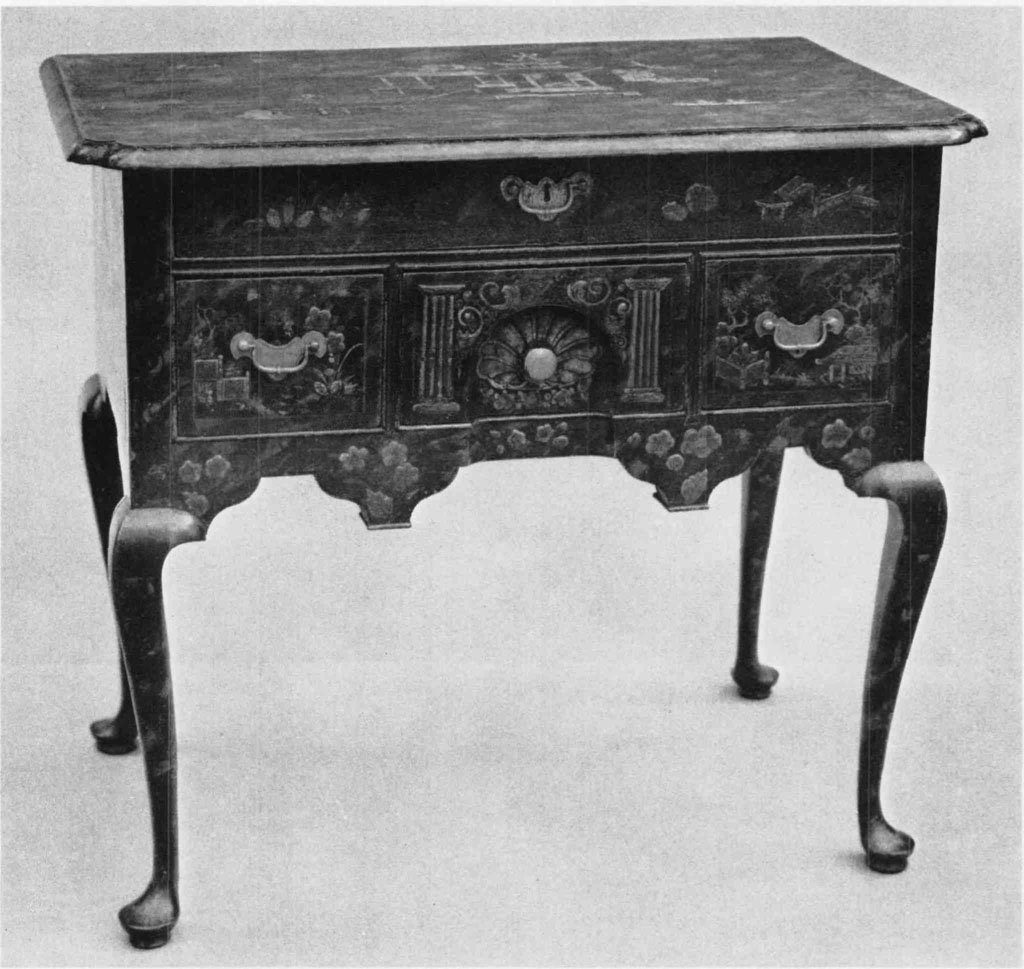
43. Dressing Table. Boston area, c. 1730–1750. Maple and white pine; h. 30½ inches, w. 34 inches, d. 21 inches. (The Metropolitan Museum of Art, Gift of Mrs. Russell Sage, 1910.)
Later japanning was done in Boston after the Revolution and into the nineteenth century, the figures not being raised and the decoration limpidly differing from the earlier work.83 A single example to illustrate a revival of the earlier motifs is seen in a Queen Anne side chair in the Bayou Bend Collection (fig. 48). One of six (two at Bayou Bend, two at Historic Deerfield, and two in the collection of Mrs. Charles L. Bybee and the late Charles L. Bybee), this chair has long been listed as being decorated later in China and owned in the Winthrop-Blanchard families of Boston.84 A study of the coat of arms on the front seat rail shows that it is identical to that used by the Boston merchant Samuel Pickering Gardner (1767–1843) on his bookplate. Gardner was guardian to his grandniece, Eliza Blanchard, after her parents died, and on March 12, 1832, she married Robert C. Winthrop.85 Thus, the family history works out; the watermark date of 1809 on Gardner’s bookplate, together with the wedding date, provides a clue to the date of the decoration. The scenes on the splat have the lustreless, stylized appearance of later decoration, and the scrolls on the stiles and legs have much in common with borders of early nineteenth-century Chinese porcelain made for the American market. The decoration was done locally, however, and the chairs did not enjoy the salt air of a trans-Pacific crossing. Other furniture was frequently redecorated in the nineteenth century by coach painters, who became the later inheritors of the japanning tradition.
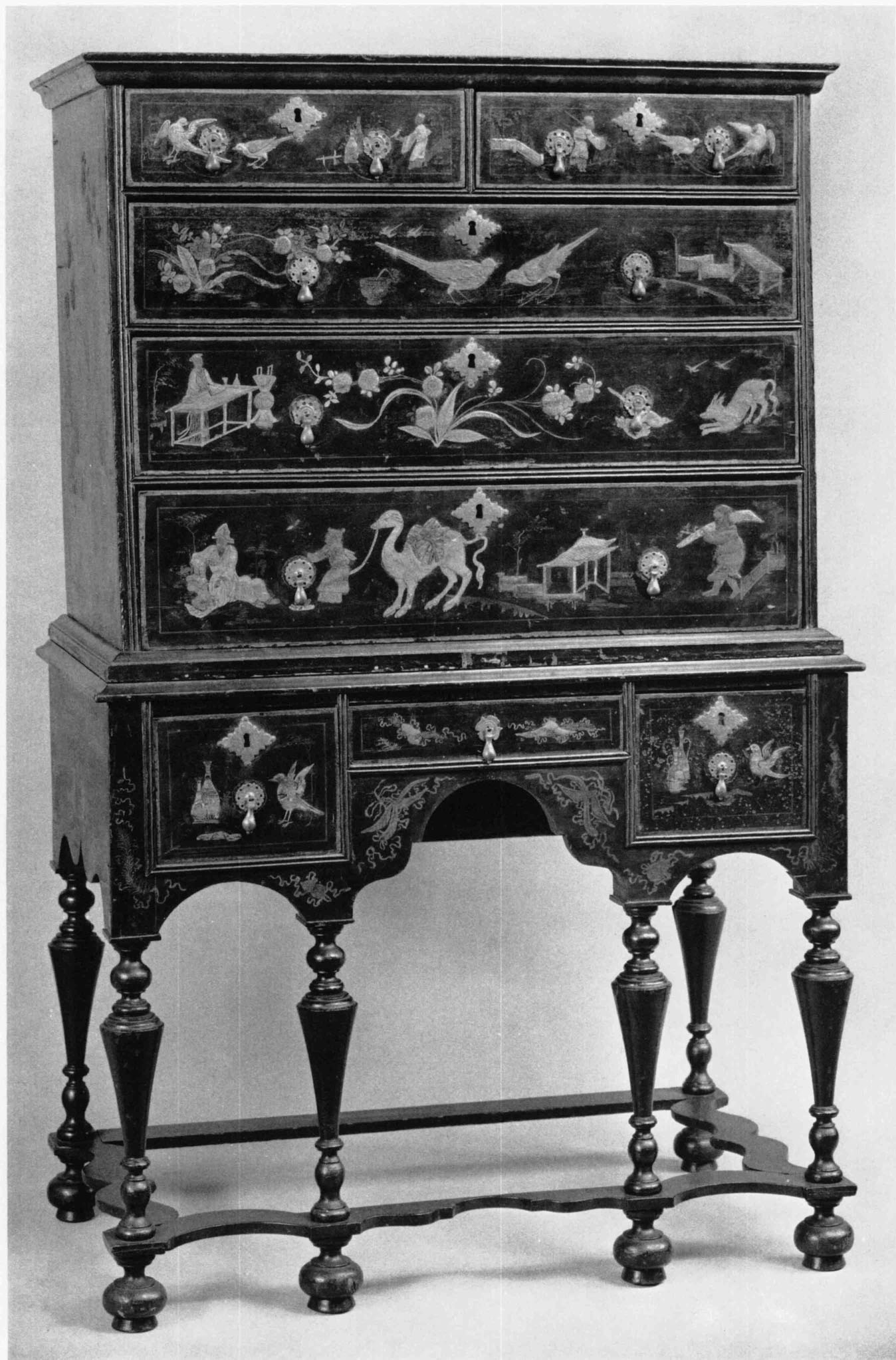
44. High Chest. Boston area, c. 1710–1725. Maple and white pine; h. 62½ inches, w. 39½ inches, d. 21¼ inches. (The Metropolitan Museum of Art, Pulitzer Fund, 1940.) This chest descended in the Pickman family of Salem.
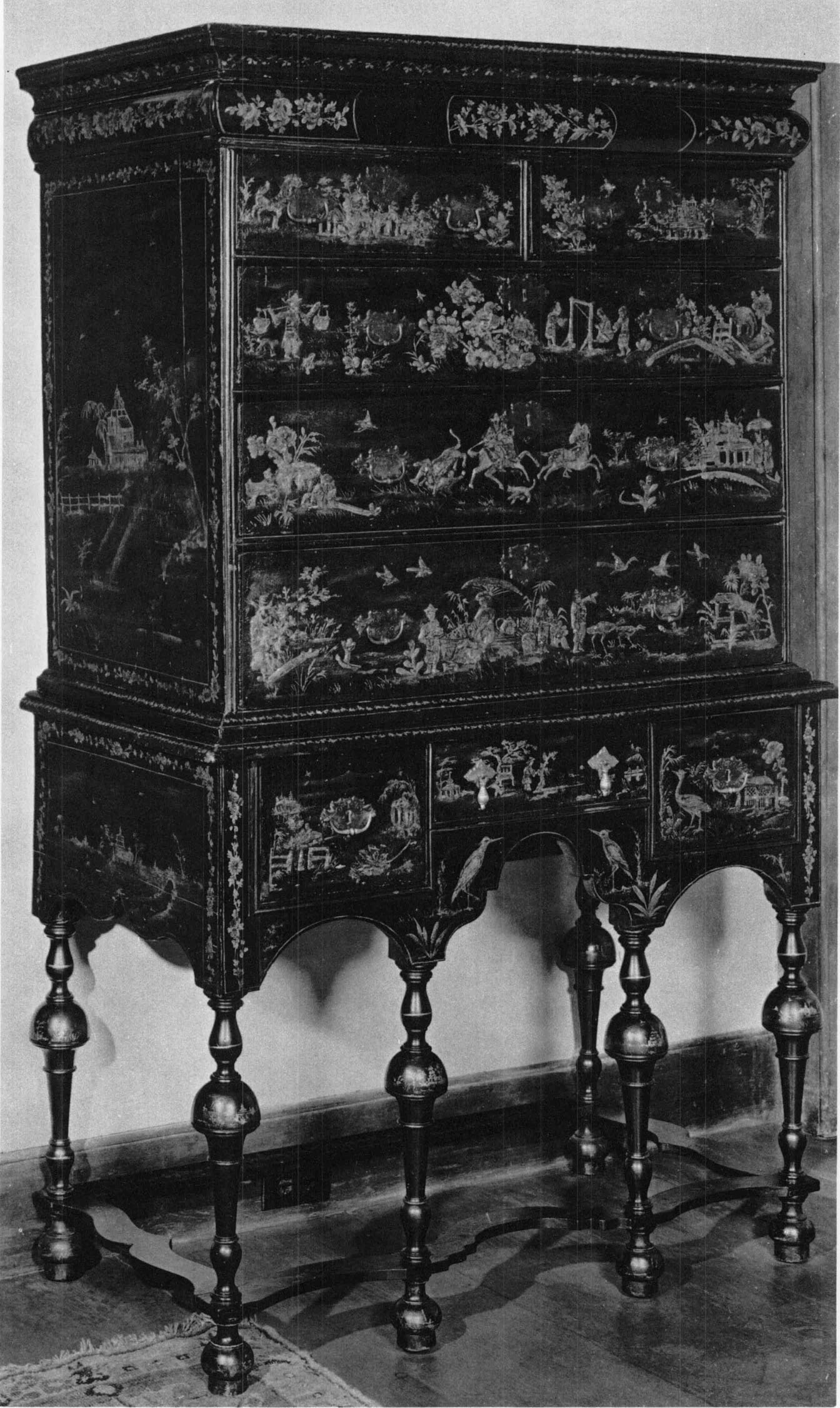
45. High Chest. Boston area, c. 1710–1725. Maple and white pine; h. 67 inches, w. 40 inches, d. 22 inches. (Historic Deerfield, Inc., Deerfield, Massachusetts.)
Boston japanning, then, continued for a century. Its heyday occurred during a fifty-year period preceding the Revolution. Much remains to be discovered about it. We should be on the lookout for tea tables and regard looking glasses with caution, since most frames were imported. They were made here, though, and japanner Stephen Whiting’s modest advertisement in the November 12, 1767, Boston News-Letter states that he “does more at present towards manufacturing Looking-Glasses than any one in the Province, or perhaps on the Continent.”
The japanning itself should be examined carefully, since it and the flat gilt decoration have frequently undergone overhelpful metamorphoses at the hands of later restorers and improvers. When working with documents, we should remember that furniture japanning was only a part of a japanner’s output, and that iron, tinware, and clock faces were japanned by most of them frequently. Also, in inventory listings of craftsmen’s possessions, when a japanned something is listed, that does not mean everything in the listing is japanned!
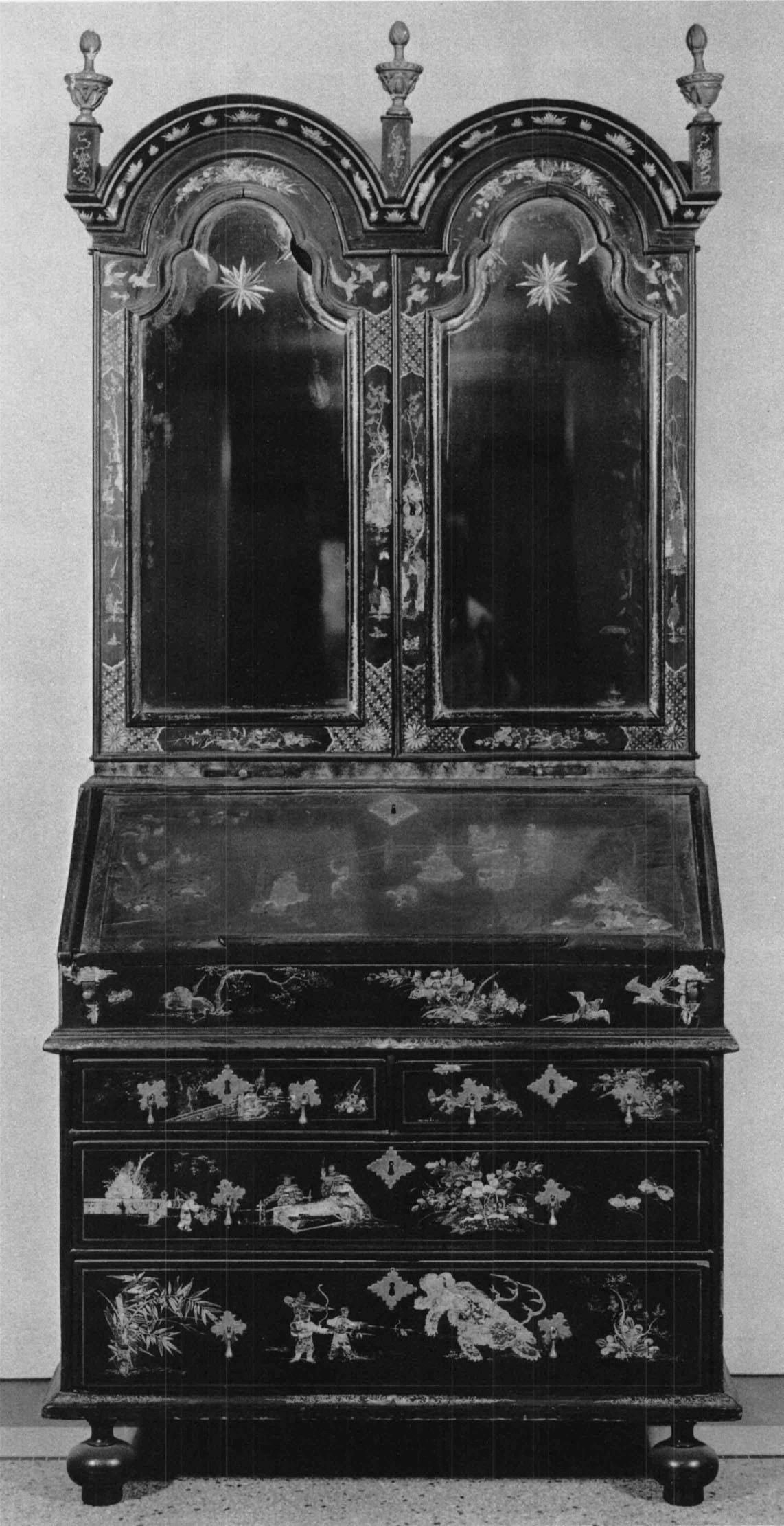
46. Desk and Bookcase. England, c. 1700–1725. h. 90 inches, w. 39 inches, d. 23¾ inches. (The Detroit Institute of Arts, Gift of Mrs. Lendall Pitts.) See also fig. 47. According to family tradition, Governor James Bowdoin (1726–1790) of Boston presented this desk and bookcase to his niece Elizabeth Pitts when she married Jonathan Warner of Portsmouth, New Hampshire, in 1781.
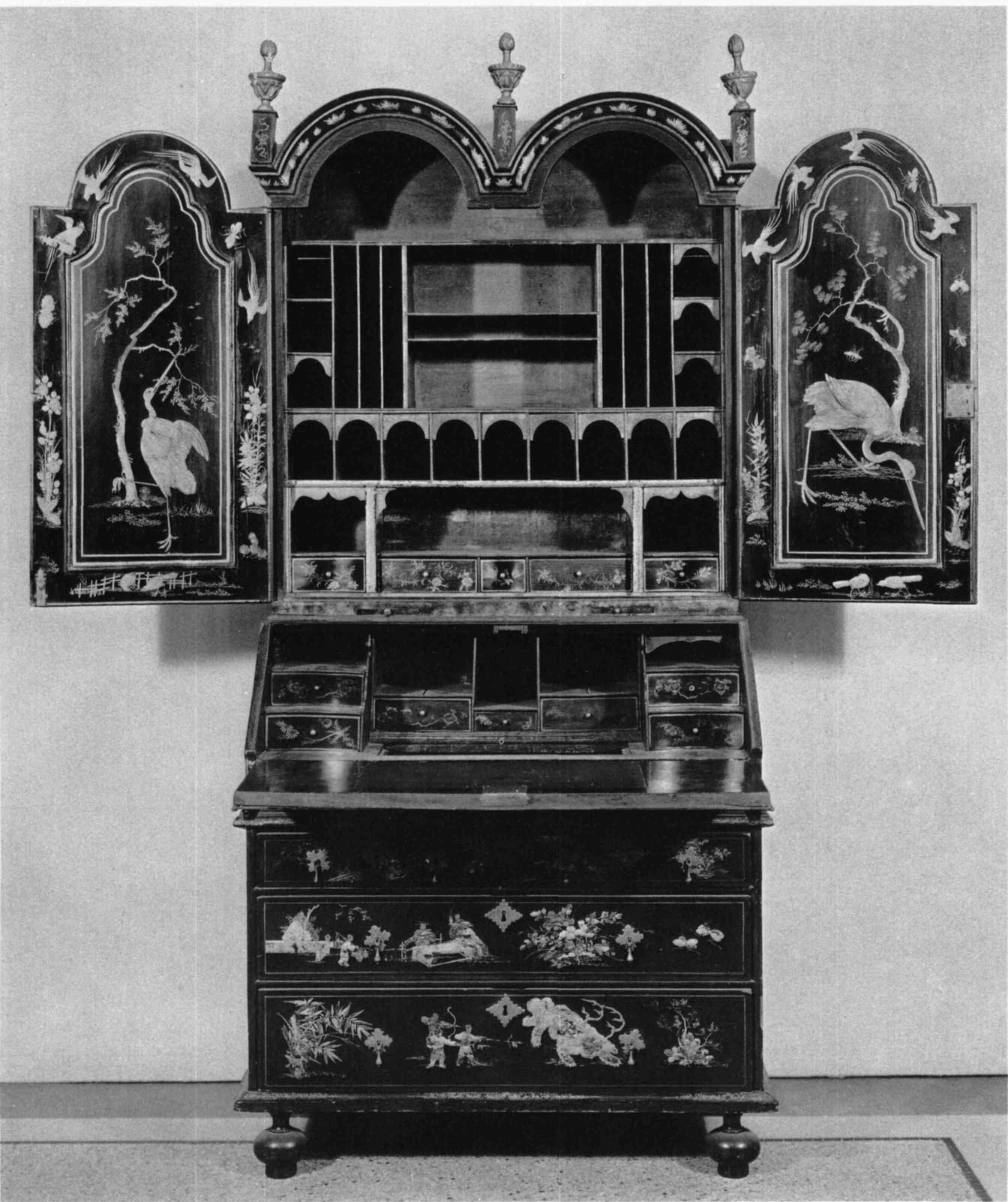
47. Interior of Desk and Bookcase. England. (The Detroit Institute of Arts, Gift of Mrs. Lendall Pitts.) See also fig. 46.
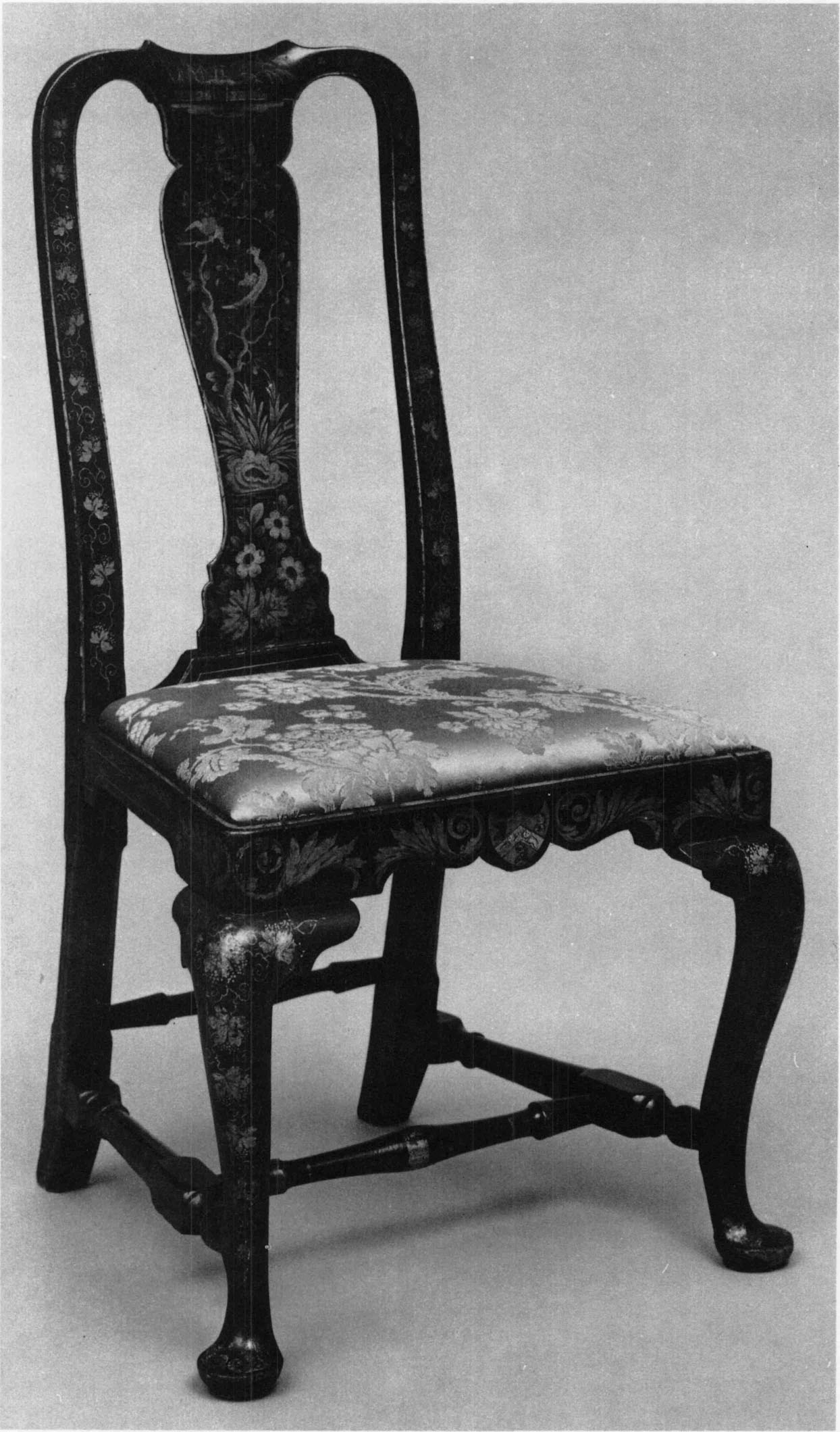
48. Side Chair. Boston, c. 1730–1760, japanning added c. 1800–1820. Walnut and maple; h. 39¾ inches, w. 20½ inches, d. 20½ inches. (The Bayou Bend Collection of the Museum of Fine Arts, Houston.) This chair was owned by Samuel Pickering Gardner (1767–1843) of Boston and later by his grandniece Eliza Blanchard.
While this article has dealt with japanning in its strictest sense, we should not forget the early simpler painted furniture influenced by it. The so-called “Harvard” chests of eastern Massachusetts and the painted casepieces from the Windsor, Connecticut, area owe much to the japanner’s art, which truly spiced many colonial homes with delicious whiffs of the distant East.86
